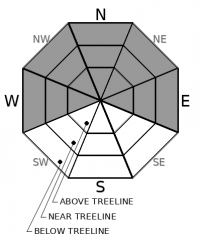| Tuesday | Tuesday Night | Wednesday | |
|---|---|---|---|
| Weather: | Cloudy. Scattered snow showers. Snow levels below 6500 feet. Chance of precipitation is 40%. | Snow. Snow levels below 6500 feet. Chance of precipitation is 80%. | Cloudy. Snow showers likely. Snow levels below 6500 feet. Chance of precipitation is 70%. |
| Temperatures: | 27 to 32. deg. F. | 22 to 27. deg. F. | 28 to 33. deg. F. |
| Mid Slope Winds: | East to southeast around 10 mph. | East to southeast around 10 mph. | Light winds. |
| Expected snowfall: | up to 1 inch. | SWE = less than 0.10 inch | 80% probability of 1 to 3 inches. 20% probability of up to 1 inch. | SWE = up to 0.25 inch | 60% probability up to 2 inches. 40% probability of no accumulation. | SWE = up to 0.15 inch. |
| Tuesday | Tuesday Night | Wednesday | |
|---|---|---|---|
| Weather: | Cloudy. Scattered snow showers. Snow levels below 6500 feet. Chance of precipitation is 40%. | Cloudy. Snow. Snow levels below 6500 feet. Chance of precipitation is 90%. | Cloudy. Snow showers likely. Snow levels below 6500 feet. Chance of precipitation is 70%. |
| Temperatures: | 24 to 29. deg. F. | 20 to 25. deg. F. | 25 to 30. deg. F. |
| Ridge Top Winds: | Southeast 10 to 20 mph. Gusts up to 30 mph. | Southeast 10 to 20 mph. Gusts up to 25 mph increasing to 35 mph after midnight. | South 15 to 20 mph. Gusts up to 40 mph decreasing to 30 mph in the afternoon. |
| Expected snowfall: | up to 1 inch. | SWE = less than 0.10 inch | 80% probability of 2 to 4 inches. 20% probability of up to 2 inches. | SWE = up to 0.25 inch | 60% probability of 1 to 3 inches. 40% probability of up to 1 inch. | SWE = up to 0.15 inch |
























